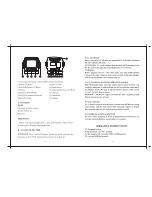
35
Instruction Manual
EL 3000 A Series
EN
Date: 05-30-2017
Figure 12
Figure 12 shows a possible progression of a set value
(U, I, P or R) with adjustable pulse widths and variable
amplitude. The rise/fall time is also adjustable, but is
equal for A and B.
If the rise/fall time is set to minimum, the signal of the
pulsed operation is a nearly ideal square wave. Figure
12 is only a clarifying view. The real progression of,
for example, an input current which is pulsed with a
frequency of 1kHz, will differ more or less. It depends
on many circumstances, like the regulation time of the
feeding power supply, the regulation time of the load, line
impedances etc.
In „pulsed“ operation the actual values are also pulsing
and the values constantly change in the display, so they
are not clearly readable.Thus the actual values are now
only indicated at pulse times >=1s (A and B each) and
can be read quite clearly by looking at them. Internally the
actual values are measured much more often (every few
milliseconds). They can always be read via an interface
card, but they are still constantly changing and are not
strictly assigned to level A or B and could thus also be
measured during rise or fall.
6.7.4 Rise/fall time
The rise and fall times are equal and are thus consid-
ered as one value. Also see figure 10. It is continuously
adjustable in a range of 30µs...200ms. The step width is
changing from µs to ms over the whole range. The error
lies at max. +10%.
The time is displayed as slew rate in the format ∆value/
time. Example: the set value of A has been set to 40A
and the one of B to 20A, then a current leap of 20A is
generated in a time x, for instance 100ms. The display
then shows 20A/100ms. The delta value is not adjustable
at this point.
Note:
the pulse widths of A and B should always be
greater than the rise/fall time, else the pulsed signal
would result in triangle-shaped wave form or something
else. For example, a pulse width of 100ms for A and B
and a rise/fall time of 100ms creates a triangle-shaped
signal with a period time of 200ms.This might be wanted
in certain applications and is thus not limited or influenced
by the device.
Handling the device
6.8 The battery test mode
Introduction
Mode „Battery“ is intended for battery tests by connecting
a battery to the load and discharge it definedly. The aver
-
age current is measured and the elapsed time is counted
and then display as the consumed battery capacity in Ah.
The voltage supervision, together with the adjustable
undervoltage shutdown threshold
Ulow
, prevents the bat-
tery from being deeply discharged. This threshold needs
to be adjusted at least once. If it is exceeded during the
test, the load input is automatically switched off and the
time counter is halted. No more current is drawn from the
battery. If the threshold is set to greater than the battery
voltage, the test can‘t be started.
Selecting the regulation mode
The regulation mode can be changed anytime,
even while
the test is running. Doing so will reset the whole test (time
counter and Ah value).
Usage
Before and during the test you can adjust the set value of
the (pre)selected regulation mode (CC, CR or CP) and the
undervoltage shutdown threshold
Ulow
. The value to set
is selected with
Selection(5)
and adjusted with
Setting(6)
.
The displays shows the elapsed test time in the format
Hours:Minutes:Seconds (HH:MM:SS), as well as the
consumed capacity in Ah.
Calculation of the Ah value
The ampere hours value (withdrawn electric charge) is
calculated from the average of the last two measurings
of the input current and the elapsed time.
Start/pause/stop the test
The test ist started by pushing the button
Input on/
off(4)
and either stops after 100 hours are counted or
the battery voltage exceeds the undervoltage threshold.
Another press of the button
Input on/off(4)
during the test
halts it, another push will continue the test. A reset of the
time counter is done by leaving the battery test mode by
switching the selector
Level Control(3)
to position
Level
A/B
or
Setup
or
by switching to a different regulation
mode with
Mode(2)
.
Note:
if external control by analogue interface is activated
(pin REMOTE = low) while the battery test is running, the
test is aborted. After external control has left again and if
the switch „
Level Control
“ is still in position „
Battery
“, the
test can be started again. Time and Ah value are reset.
Note:
if the regulation mode is changed by
Mode(2)
, all
other set values that are not adjustable for the selected
regulation mode are set to default values in order to let
the test mode work correctly. Hence the setting
Keep set
values
is ineffective here.
The example in figure 13 shows that the current of 100A
can not be reached because the power limitation has
become active (example of a 2400W model).
Note:
The time display is not 100% exact. The deviation
of the displayed time to the actually elapsed time can be
1-2 seconds per hour.










































